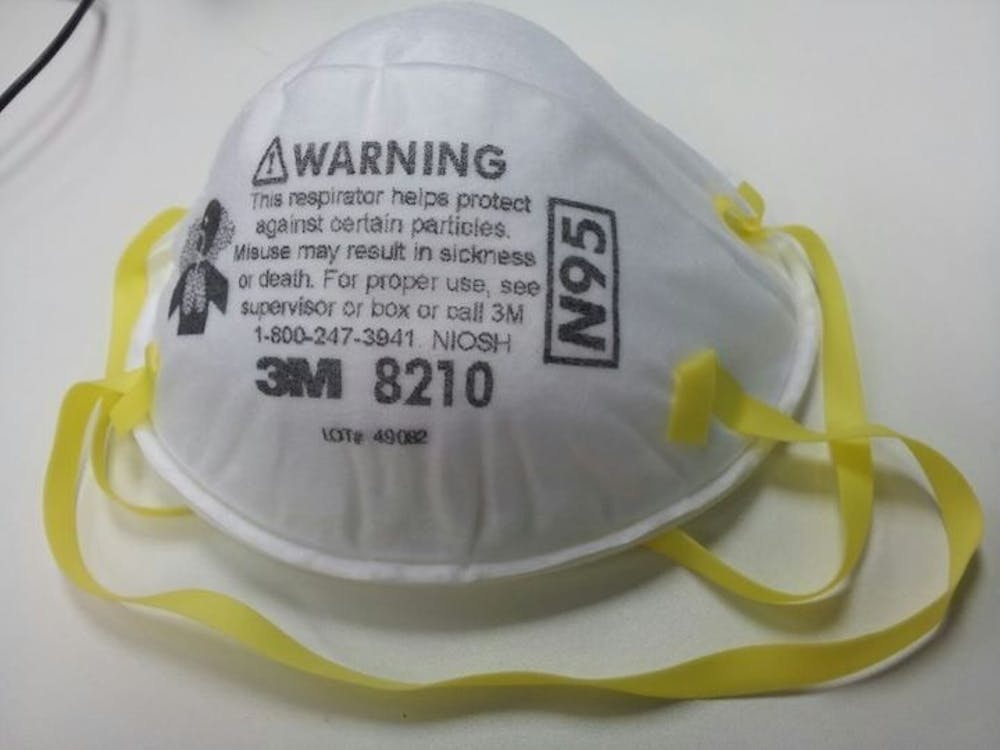Masks: the latest accessory to top off any Duke student’s outfit. But which mask is best?
What type of mask to wear, controversial since the beginning of the COVID-19 pandemic, is the center of new debate following an article by Duke researchers that many took as a warning to not wear neck gaiters. According to Martin Fischer, associate research professor in the department of chemistry and one of the main researchers of the article, that’s not the right interpretation.
“It was a development of a simple technique. It was not a systematic study of masks,” Fischer said. “The interpretation was that all neck gaiters suck. That is not what we said.”
The research article, “Low-cost measurement of face mask efficacy for filtering expelled droplets during speech,” gained widespread attention after its Aug. 7 publication.
The researchers tested droplets expelled from a speaker’s mouth. The speaker was recorded with 14 commonly available masks, repeating the sentence “Stay healthy, people” five times for each mask. The researchers used a computer algorithm to count how many droplets were expelled by the speaker while wearing each mask.
The paper explained that the technology they developed recorded more droplets from the speaker’s mouth when they were wearing the neck gaiter as opposed to the control. The paper indicated that the droplets appeared to disperse smaller as well. This particular finding garnered a large amount of media attention.
“Seeing the media somewhat misquote and misinterpret the data was a big downer,” Fischer said.
Because of the popularity of the article, some manufacturers emailed the researchers about how this study impacts the development and sale of their masks. Fischer noted that the majority of responses from these companies were supportive and positive, with some companies offering to send masks to set up testing.
According to a GlobalNewswire report, the mask industry is projected to be $21.2 billion by 2026. While almost every clothing retailer, online or in person, has started selling masks, many sold are untested because there is not yet a standard procedure for assessing a mask’s protectiveness. The article’s technique for testing masks is intended to be inexpensive and “can be built and operated by non-experts,” the abstract reads.
However, some of the responses to the article, particularly from neck gaiter manufacturers, were negative. Fischer received emails with concerns that the research will hurt the neck gaiter business business.
“We are not killing business—we are developing a technology. It is not our intention at all to ruin a business,” Fischer emphasized.
The development of the technique detailed in the paper began in May as a side project for the researchers. The research was not funded through Duke and used equipment the researchers already had lying around in the lab. The 14 masks were donated by the researchers’ collaborators. Additionally, the research was structured to take place mainly on weekends so that it did not interfere with the researchers’ other studies.
Unlike most science research papers, which may take around a year to complete, this paper was completed in less than five months. Additionally, while many research articles are most popular within the scientific community, 91% of readers of this paper are members of the general public.
“It’s important to point out that this is not your typical research,” Fischer said.
Emma Fischer, another researcher on the paper and a Duke junior, agreed with her father that the public reaction “oscillated” since the publication of the paper.
“I don’t think anything I ever do will have this much attention,” said Fischer, who plans to continue pursuing research after college. “It was a nice introduction to do something that I want to do for the rest of my life.”
For future studies, the researchers do not plan on testing more masks or testing masks on a larger sample size. Instead, they plan on improving the testing technology outlined in the paper, including refining the sensitivity of recording droplets and identifying if droplets are coming through the mask itself or through the sides. This further research would require a funding stream, which the researchers are currently looking for.
“We’re not going to be the Duke mask certification site,” Fischer said.
Soon after the popularization of the article in the media, Fischer’s email inbox became flooded with requests for mask recommendations, from people such as coaches of sports teams wanting to know how to best protect their players.
“I’m not giving out mask recommendations. I don’t think there's a simple answer to the question anyway,” he said. “I don't think there's a one size fits all. There's a reason people in the medical center wear a different mask than people that run around outside.”
He noted that various factors, such as if a person is moving or still, indoors or outdoors, and length of wear are relevant to choosing a mask. According to Fischer, picking the perfect mask is “a trade-off between comfort and protection.”
“The type of mask you wear really depends on your circumstances. It depends if you’re wearing them for five minutes, or if you’re wearing them all day,” Fischer said. “If you have to wear a mask all day outdoors, you can’t wear the super tight fitting ones. It’s just not practical.”
He also noted that while N95 masks are “awesome,” they are in short supply and should be left to “the people who really need them.”
Get The Chronicle straight to your inbox
Signup for our weekly newsletter. Cancel at any time.

Paige Carlisle is a Trinity senior and a staff reporter for The Chronicle.

